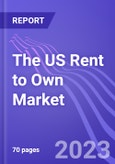This report comes with 10% free customization, enabling you to add data that meets your specific business needs.
A rent-to-own (sometimes known as "lease purchase") agreement allows buyers the chance to lease a house with the opportunity to purchase it later. On a monthly basis, the tenant/buyer pays the landlord/seller a sum equivalent to the rental amount. A part of the monthly payment is then put to the purchase price of the home. The tenant/buyer has the sole right to purchase the residence during or at the conclusion of the lease period on the conditions agreed upon by both parties.
The rent-to-own market is expected to exhibit a favourable outlook in the coming years as major and subprime lenders tighten lending standards. Furthermore, demand for critical items (appliances and computers) is expanding and would likely increase further in the near future. The US rent to own market is expected to reach US$11.95 billion in 2023, growing at a CAGR of 6.77% during the forecast period.
Segment Covered
By Distribution Channel: In terms of distribution channel, the report provides the bifurcation of the US rent to own market into two segments: Brick & Mortar and E-commerce. E-commerce channel held the largest market share and is expected to grow at a significant CAGR in the forecasted period. Stay at home and social distancing orders have been imposed all across the US due to the outbreak of COVID-19. This in turn has led to more and more people preferring e-commerce channels for purchasing various things on lease.
Top Impacting Factors
Growth Drivers
- Significant Population of International Migrants
- Growing Millennial Population
- Spike in Urbanization
- Rising Virtual Rent-to-Own Market
Challenges
- Dependency on Vendors, Suppliers and Products
- Lack of Customer Security
Trends
- Hike in Internet Penetration
- Rollout of Smartphone as New Category
- Rapid Pace in Technological Advancements
Driver: Significant Population of International Migrants
Better employment and education opportunities has been a catalyst for migration of people from other countries into the US. The immigrant population does not want to spend money on purchasing permanent home and other major accessories because of rotating nature of their job or some other reasons as well. Therefore, they have been preferring to rent homes and other major household items such as furniture from rent to own providers. And, in case they want to reside permanently, they pay monthly installments and finally posses the ownership. The high number of international migrants in the country has been a crucial driver for the RTO market in the country over the last decade or so.
Challenge: Dependency on Vendors, Suppliers and Products
Company’s rely on the receipt of information from third party data vendors, and inaccuracies in or delay in receiving such information, or the termination of company’s relationships with such vendors, could have a material adverse effect on the business, operating results and financial condition. Additionally, allegations of or actual product safety and quality control issues, including product recalls, could harm company’s reputation, divert resources, reduce sales and increase costs. Furthermore, If the company are unable to successfully appeal to and engage with the target consumers, the business and financial performance may be materially and adversely affected.
Trend: Rapid Pace in Technological Advancements
Technology is the base for usually all types of industries and with different invention coming due to growth demand, many industries are expected to gain benefit in different ways. The pace of technological advancements has increased rapidly due to increasing internet uses and digital communication making the ecosystem faster and considerably reduced. In the US, consumer of rent-to-own industry want to use the advanced technology. In-home service market, new platforms for marketing is extending the reach of many companies, whereas new improved software and programs are providing the companies new opportunities for upgrading their services, for instance, better query solving system, proper and simplified booking system, tracking the status of customer service, etc.
The COVID-19 Analysis
The epidemic of Coronavirus illness (COVID-19) had a significant impact on the US rent to own market, as governments around the world implemented lockdowns. However, the market's total impact was favorable in 2020. The enterprises saw a loss in revenue for the first quarter of the year, however the industry recovered due to increased demand for house ownership, higher rental prices, and other factors. The rent-to-own industry in the US is likely to grow further in the future, owing to the rapid speed of technology improvements, more e-commerce in home purchases, and so on.
Analysis of Key Players
The US rent to own market is fragmented with the presence of a large number of players majorly dominating the country. Key players of the US rent to own market are The Aaron's Company, Inc., Rent-A-Center Inc., goeasy Ltd., Co-Ownership Organization, EZ Furniture Sales & Leasing, FlexShopper Inc., Buddy's Home Furnishings Company, Snap Finance Company, Home Partners of America Company (HPOA), Dream America Organization, Action Rent to Own, Divvy Homes, Zerodown, and Verbhouse.
Please note: 10% free customization equates to up to 3 hours of analyst time.
Table of Contents
1. Executive Summary
Companies Mentioned
- Action Rent to Own
- Buddy's Home Furnishings Company
- Co-Ownership Organization
- Divvy Homes
- Dream America Organization
- EZ Furniture Sales & Leasing
- FlexShopper Inc.
- Home Partners of America Company (HPOA)
- Rent-A-Center Inc.
- Snap Finance Company
- The Aaron's Company, Inc.
- Verbhouse
- Zerodown
- goeasy Ltd.








